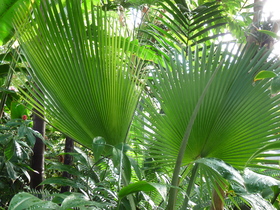
When you think of palm trees, what images come to your mind? Is it a tall coconut-bearing palm tree on a sandy beach with the sounds of ocean waves crashing and sea gulls calling? Or do you think of a tropical forest where you might see a sloth or hear a monkey screech?
There are over 2,600 known species in 200 genera of palm trees in the world with their nativity ranging from an oasis in Africa to the dense, dark rainforests of South America. In the Boettcher Memorial Tropical Conservatory you have an opportunity to see a handfull of these palm trees. Be sure to look at the leaves. Are they pinnate (leaves radiating from a central spine, like a feather) or palmate (leave radiating from a central point, like your fingers on your hand)? Also look at the trunks on these plants. Are they colorful or spiny? They all are quite unique and provide a graceful backdrop to the other plants in the Conservatory.
These plants of the family Arecaceae have economic importance as well, providing fruits such as dates and coconuts; leaves that can be used for paper, shelter and weaving; palm hearts or palm cabbage comes from young apical buds and leaves; starches from the trees' pith; and the sap can make beverages such as palm wine or even a sugar which is known as gur or jaggery.
Most grow natively in the well-watered zones of the world, in latitudes from 33 degrees north in the United States and to 43 degrees south in New Zealand. Some palm trees grow up to 4,000 meters in altitude. Most palm tree species are not widespread and many are endemic to islands or other small regions of the world. Palms are responsible for producing the largest seed in the world (Lodoicea maldivica which weighs in at 20 kg), the longest leaf (Raphia regalis measures over 25 meters) and the largest inflorescence (Corypha umbraculifera which may have as many as 10 million flowers on one inflorescence). Many palm trees are endangered and are extremely rare in their native habitat. It is one role of botanic gardens to conserve rare and endangered plants by cultivating, studying and preserving their genetic material through seed collection and distribution and propagation as well as public education.
To learn more about palm trees, tropical plants or endangered plants visit the Helen Fowler Library.
Updated February 2019
|








